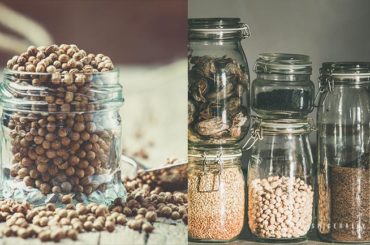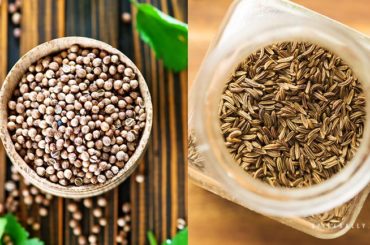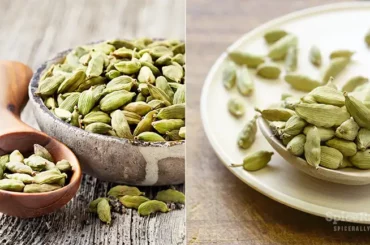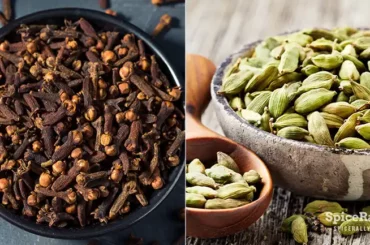Hailing a history that runs back to nearly 4000 years, turmeric is one of the miraculous culinary spices you SHOULD have at home. Need to know why? Let us enlighten you with everything about this incredibly beneficial golden spice!
Turmeric (Curcuma longa) is a rhizome that belongs to the ginger family (Zingiberaceae). This is a common culinary spice that is used for flavoring and coloring. In addition, turmeric contains a major component called “Curcumin,” which gives this spice its many medicinal values. Thus, from conventional usage in cooking, this spice is beneficial for other beauty and health-related uses.
Of course, we have a bunch of things to share with you about this wonderful golden spice. So, keep reading to discover the most amazing facts you never knew about turmeric!
What Is Turmeric?
Turmeric is native to tropical South Asia and comes with ancient history that dates back to Vedic culture in India. This spice is also known as the “golden spice,” mainly for two reasons. One- since it has a golden-yellowish hue, and second because it has a medicinal value which its worth isn’t inferior to that of gold.
The spice we use comes from the rhizome of a flowering, perennial plant (Curcuma longa), which belongs to the ginger family (Zingiberaceae). Sometimes the rhizome is used in its natural state, or else it is boiled, dried, and powdered to facilitate its usage in cooking.

Turmeric is among the first three primary culinary spices used in South Asian countries. And India is the largest producer, exporter, and consumer of turmeric in the world. At the same time, Sri Lanka, Pakistan, Thailand, Middle Eastern countries, and apparently, this spice is spreading widely in American and British cuisines as well.
According to the 2021 statistics, the USA has imported this spice valued at approximately 39.06 million U.S. dollars from India. While turmeric has the capability to complement a wide variety of dishes, over 6000 research has proved its invaluable health benefits.
What is Wild Turmeric (Kasturi Manjal)?
Wild Turmeric, or Kasturi Majal, as popularly known in India, belongs to the same plant family as regular turmeric. This is another variety of turmeric and is widely grown in South India and the eastern Himalayas.
It is native to Tamil Nadu and has been used by South Indian women in their regular beauty care routine since ancient days. Kasturi Manjal has rhizomes with a distinct fragrance and is usually pale yellow in color. This variety is much bitter than regular turmeric. Thus, it is only used for topical uses but not included in cooking.
This wonder ingredient is accredited with powerful health properties. Therefore, it is broadly used in traditional medicine for external applications to cure skin diseases, bruises, sprains, and snake poison.
Furthermore, thanks to its skin health-boosting properties, it is also used to make many skin care products like creams, lotions, exfoliators, soaps, etc.
Curcumin- the active ingredient in Turmeric
Curcumin is a bright yellow pigment found primarily in turmeric that is a polyphenol with anti-inflammatory properties and the capability to boost the amount of antioxidants that the body produces.
This component is absorbed by the body mostly when digested through food. Yet, modern medicine incorporates this ingredient into many other forms to improve its bioavailability.
What Forms Does Turmeric Come In?
Most of us are familiarized with the powdered form of turmeric since it is the most effective state we use to incorporate into cooking most of the time. But it also comes as fresh turmeric, paste, teas, capsule/ pills, extracts, and essential oil.
Fresh Turmeric
Fresh turmeric has a more vibrant flavor than dried. It has a bright yellow-orange flesh that is earthy, peppery, and a little bitter. Like ginger, you will have to scrape off the peel before using it. It can be cut into thin slices, strips, or even diced.

You can also grate or juice fresh turmeric if you need to incorporate it into smoothies or drinks. Avoid pale, dried, or wilted ones when buying. And you can store them in the refrigerator in a tightly-sealed container for up to two weeks or freeze them for several months.
However, fresh turmeric is hard to find. But if you really need to find them, you can try them in Asian grocery stores.
Dried Turmeric
You can find dried turmeric ground and whole. Dried turmeric is made by boiling the fresh turmeric rhizomes, sun or oven drying them, and then pulverizing them into a fine powder.
However, dried or powdered turmeric is less potent than fresh turmeric, which is a common scenario for all spices. Nevertheless, the aroma is often a better quality indicator than color when purchasing powdered turmeric, which can vary.
Dried turmeric usually has a longer shelf life than fresh turmeric. You can store it in a cool, dark, dry place with other spices in a well-fitting glass container for up to six months to one year.
Teas And Essential Oil
You can make turmeric tea at home using fresh or dried turmeric. Or else, commercially, turmeric extract is integrated with other ingredients to make different types of healthy herbal teas. You can find many tea blends in which turmeric is paired with honey, orange, peach, ginger, lemon, etc.

Turmeric essential oil is a valuable product in the pharmaceutical endeavor due to its overall beneficial health effects. This form is comparatively more expensive than any other common form of turmeric.
However, turmeric essential oil is widely used in aromatherapy, hair care, to treat minor cuts or bruises, and to infuse in beauty products and perfumes.
How To Use Turmeric?
Turmeric is literally considered an all-in-one spice in the world. As we all know, that is a flavoring used to make exotic dishes; it is genuinely much more versatile than we think. Turmeric is known as the “internal healer” in Ayurveda for its exceptional medicinal value.
Cooking With Turmeric
This is popular in Asian communities as a spice used to make curries. Powdered turmeric has an incredible earthiness and warm, peppery, musky, bitter undertones with a bright yellowish-golden hue.
Therefore, it is much known as a colorant flavoring and features in most universal spice/seasoning blends and pastes such as:
- Chili powder
- Thai yellow curry paste
- Ras el Hanout
- Moroccan spice blend
- Garam masala
- Sambar Powder
- Vindaloo curry paste
- Tikka masala powder
Besides curries and blends, turmeric is commonly used in mustard pickles and chutneys. It is important to remember that its taste is robust, so a little goes a long way.
In fact, turmeric can be included in many dishes, from rice dishes and baked butternut squash to lentil or coconut noodle-based soup and marinades. In addition to its contribution to a bulk of savory dishes, this spice also plays a significant role in flavoring and coloring baked goods and sweets like:
- Cakes
- Bread
- Cookies
- Buns
- Oatmeal bars
- Energy balls
- Smoothie bowls
Moreover, turmeric tea is another common way this spice is used in the kitchen. As mentioned previously, turmeric tea can be made by steeping powdered or fresh turmeric in hot water with other ingredients. This has been a part of a compulsory healthy diet practiced by the Indians for many years.
Other Uses Of Turmeric
Turmeric is recognized as a potent spice in modern medicine and cosmetology. Thus, we can find a myriad of ointments, creams, lotions, soaps, perfumes, etc., containing turmeric.
In addition, this is also used in many DIY skincare outcomes, such as face masks, scrubs, and skin-removal creams. Some even combine this ingredient in bath salts for its incredible skin brightening, healing, and soothing properties.
Traditional Uses Of Turmeric
In addition to cooking, turmeric is a prominent ingredient in many traditional Indian rituals. They consider this spice to be a noble, protective ingredient that should be included in their most auspicious events.
For example, the Haldi Ceremony is one of their major functions. This is usually held before a wedding, where they festively apply turmeric with oil and water to both bride and groom to bless them with fortune, fertility, and protection.
In addition, they include turmeric to make many of their sweetmeats and incorporate this in many of their religious events. Not only in India, most Hindus and Buddhists living around the world believe that integrating turmeric into their religious rituals would ensure spiritual purity.
Each spice has a special day to it. For turmeric it is Sunday, when light drips fat and butter-colored into the bins to be soaked up glowing, when you pray to the nine planets for love and luck.
Chitra Banerjee Divakaruni
What Can I Substitute For Turmeric?
We now know that turmeric is simply an unparalleled spice in our pantry. But still, we should find alternatives if we ever run short of it. In such instances, we should be concerned about choosing a possible option that could replace the coloring effect and flavor of this spice.
Saffron can be regarded as the closest substitute for turmeric since it gives the required color, and the flavor difference also would not be much of an issue. As for the other possibilities, we can count on annatto, safflower, ground cumin, dry ginger powder, curry powder, etc.
Why is turmeric good for you?
We mentioned from the beginning that turmeric is a spice that reaches beyond the kitchen. In fact, this plant is known for its remarkable health properties. Studies have proved that turmeric contains anti-inflammatory, anti-cancer, and anti-bacterial properties along with cardio-protective and hepatoprotective effects.
In addition, this spice is also an excellent treatment for depression and to treat patients with Alzheimer’s disease. Turmeric has been used since the ancient days for treating specific ailments such as:
- Rheumatoid arthritis
- Chronic anterior uveitis
- Conjunctivitis
- Skin cancer
- Smallpox
- Chickenpox
- Wound healing
- Urinary tract infections
- Liver ailments
- Jaundice
- Menstrual difficulties
- Loss of appetite
- Inflammatory bowel disease
- Dyspepsia
Accordingly, due to the proven health benefits of turmeric, including it in your regular diet will help you to stay away from many diseases and common ailments. Furthermore, incorporating it into your standard beauty regimen will give you bright, glowing, youthful skin and strong, healthy hair.
How does turmeric grow?
Turmeric is a perennial plant to 1m tall with underground rhizomes. It has big green leaves and grows three or more feet tall. And each stem sends up a tip of pale, greenish-white, and sometimes pink flowers as the plant grows.
This plant demands a frost-free climate, well-drained soil, and 1000 to 2000mm of rain annually or supplemental irrigation. It succeeds best on alluvial or loamy fertile soils and cannot endure waterlogging. The heavy shade will downsize the yield, but the light shade is helpful in getting a better crop.

Can I grow turmeric at home?
You are lucky enough to grow your own turmeric if you have neutral, thoroughly-drained soil with a sunny spot at home!
You can first plant your rhizomes in small pot planters and then transfer them to larger pots as needed if you are growing them indoors. Make sure to get at least 12-18 inches deep pots so that the rhizomes have space to develop.
Since the plants can grow from 3-3.5 feet tall, you will need to have enough space for them to flourish as they mature. You can water the plants every two to three days. And when taken care of properly, they will start to sprout from six to ten months.
Isn’t Mellow-Yellow Turmeric Good To Be Your Pantry Staple!
Turmeric is an aromatic South East Asian spice with a depth of flavor and potent coloring effect. It is used widely in cooking and is credited for its outstanding medical properties and health benefits. While you can flavor and color your dishes using this spice, it can also be used in many ways to enhance skin and hair health.




